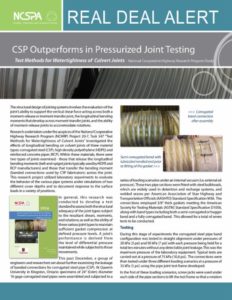Corrugated Steel Pipe Outperforms in Pressurized Joint Testing
The latest Real Deal Alert is now available from the National Corrugated Steel Pipe Association. The new edition highlights research and testing of Corrugated Steel Pipe, as well as highlights several case studies.
The structural design of joining systems involves the evaluation of the joint’s ability to support the vertical shear force acting across both a moment-release or moment-transfer joint, the longitudinal bending moments that develop across moment-transfer joints, and the ability of moment-release joints to accommodate rotations.
Research undertaken under the auspices of the National Cooperative Highway Research Program (NCHRP) Project 20-7, Task 347 “Test Methods for Watertightness of Culvert Joints” investigated the effects of longitudinal bending on culvert joints of three material types: corrugated steel (CSP), high density polyethylene (HDPE) and reinforced concrete pipes (RCP).
The latest Real Deal Alert is now available from the National Corrugated Steel Pipe Association.
The new edition highlights research and testing of Corrugated Steel Pipe, as well as highlights several case studies.
Within these materials, there were two types of joints examined – those that release the longitudinal bending moments (bell-and-spigot joints typically used by HDPE and RCP manufacturers) and those that transfer the bending moment (banded connections used by CSP fabricators) across the joint.
This research project utilized laboratory experiments to evaluate the behavior of the various pipe systems under simulations of two different cover depths and to document response to the surface loads in a variety of positions.
In general, this research was conducted to develop a test standard to assess both the structural adequacy of the joint types subject to the resultant shears, moments, and rotations; as well as the ability of these various joint types to maintain sufficient gasket compression at defined pressure levels.
A joint’s performance is derived from the level of differential pressure maintained while subjected to those movements.

